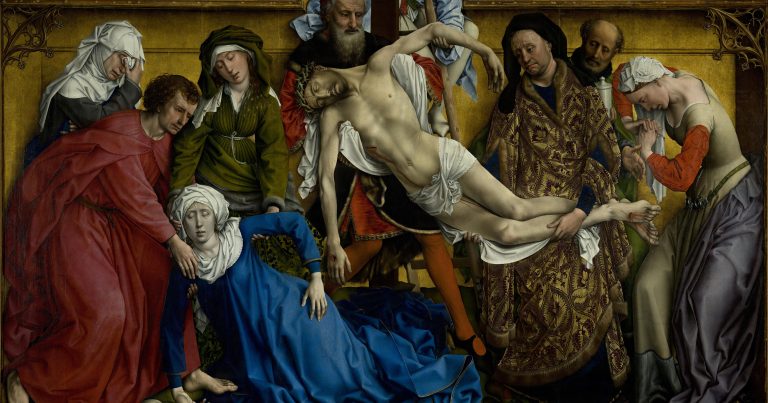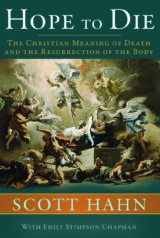By Regis Flaherty
Regis Flaherty is a bestselling author of several books, including Jesus Is the Gift: The Spirituality of Advent & Christmas, which is the fruit of over seven years of preparing others for Advent through talks on its liturgical themes.

Christ truly died on the Cross. It was not faked, and it was not a trick or sleight of hand. His death was the real thing, involving pain, aloneness, and removal from the living. Yet when He bowed His thorn-crowned head and uttered the earth-shaking words, “It is finished” (John 19:30), it was not His life that was finished but rather the reign of death. Christ was laid in a tomb but only to burst forth, pushing aside the stone that separated the dead from the living, a stone that symbolized the death sentence of all humanity. By His Resurrection not only was the tomb’s stone thrust aside, but the very gates of heaven were opened.
Now we, with everyone who has died before Christ, with everyone who has died since Christ, and with everyone who will die, can shout in the face of death: “O death, where is thy victory? O death, where is thy sting?” (1 Cor 15:55).
If Christ conquered death and has shared His Resurrection with us, why do we still experience death with the pain, aloneness, confusion, and separation that accompanies it? Were then the sin of Adam and the power of the tempter so strong in its evil that even God could not overcome it?
No! Christ has overcome death. “The Christian meaning of death is revealed in the light of the Paschal mystery of the death and resurrection of Christ in whom resides our only hope. The Christian who dies in Christ Jesus is ‘away from the body and at home with the Lord’” (CCC 1681). Yet it does take the eyes of faith to see the victory clearly. Scripture tells us that in this life our sight is blurred. “At present we see indistinctly, as in a mirror, but then face to face. At present I know partially; then I shall know fully, as I am fully known” (1 Cor 13:12, emphasis added).
The reality of the defeat of death and the promise of resurrection are given to us now sacramentally. That does not make the truth less real. In fact, the reality is rock solid because it is based upon Christ and His salvific work. Sacraments “are efficacious signs of grace, instituted by Christ and entrusted to the Church, by which divine life is dispensed to us. . . . They bear fruit in those who receive them with the required dispositions” (CCC 1131).
Any comparison of a heavenly reality with an earthly example will limp. However, comparisons can help our minds wrap around the divine truth.
If I receive a wound, the doctor will stitch my skin, closing the wound. Thereby the problem of an open wound is resolved, but I’ll continue to see the sutures, at least for a time, and the scar will only gradually fade. Another example? If a wealthy man gives a pauper a checkbook, he is no longer poor. Yet until he cashes a check and realizes the fruit of the gift he will still look like and live as a pauper.
Now let’s move to the spiritual reality and apply our comparisons. The hope of resurrection is realized in the Sacrament of Baptism. It is a hope that is sure (see Titus 3:4–8). That sacrament deals with the wound we have inherited from our first parents, called original sin. Yet we will still see the effects while we walk this earth. Even after Baptism, concupiscence still troubles us. The Catechism of the Catholic Church teaches that, “certain temporal consequences of sin remain in the baptized, such as suffering, illness, death, and such frailties inherent in life as weaknesses of character, and so on, as well as an inclination to sin that Tradition calls concupiscence, or metaphorically, ‘the tinder for sin’” (CCC 1264). We still live with a “scar.”
God gives us what we need both to respond to Him and to persevere, such that we will enter into a heavenly relationship with the Triune God when our physical life is ended. Through Baptism we become God’s children. Jesus, therefore, is our Brother. He is the Firstborn (Rev 1:5) who has gone into the heavens to prepare a place for the rest of the family (John 14:2). The door is open from the inside. We, the living, still stand outside, but we are gifted with all the help we will need to make the short trip through this life and enter into eternal bliss. Christ, who has shattered sin and death, gives us help to endure in this life, and to triumph in the next.
The Church names that help grace. It “is favor, the free and undeserved help that God gives us to respond to his call to become children of God, adoptive sons, partakers of the divine nature and of eternal life [emphasis added]” (CCC 1996). It’s as good as money in the bank. Similar to our example of the bank and the pauper above, we need only to draw down from the deposit He has given. The freedom of the children of God countermands the servitude of sin. The recipient truly is incorporated into Christ. He or she does receive grace and the theological virtues of faith, hope, and charity. By nurturing these gifts, each of the baptized will see the full flower of his or her hopes.
In Christ the victory is assured. The wound has been sutured, even though the scar is still evident. The money is in the bank, but we have yet to realize the fullness of the gift. Scripture tells us that Jesus is “the first-born of the dead” (Rev. 1:5). And the Church teaches: “Through Baptism the Christian is sacramentally assimilated to Jesus, who in his own baptism anticipates his death and resurrection. The Christian must enter into this mystery of humble self-abasement and repentance . . . so as to become the Father’s beloved son in the Son and ‘walk in newness of life’” (CCC 537).
You Might Also Like

In Hope to Die: The Christian Meaning of Death and the Resurrection of the Body, Scott Hahn explores the significance of death and burial from a Catholic perspective. The promise of the bodily resurrection brings into focus the need for the dignified care of our bodies at the hour of death. Unpacking both Scripture and Catholic teaching, Hope to Die reminds us that we are destined for glorification on the last day.